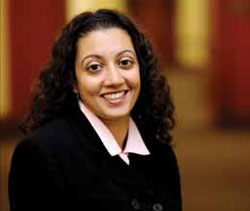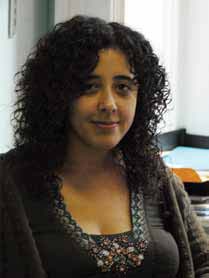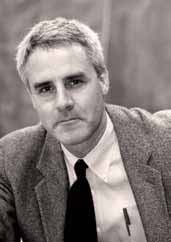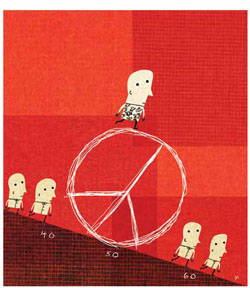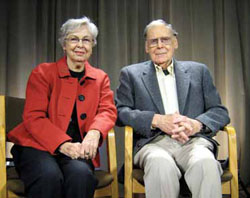Good Neighbors Who Both Mend Fences
TC is home to complementary-'"and groundbreaking-'"initiatives in peace education and conflict resolution
As someone who has spent a good part of his career focusing on conflict resolution, Peter Coleman recognized familiar patterns in President Barack Obama’s first major speech before Congress.
“He was really trying to identify higher goals that we all share to mobilize people to rise above the fray of partisanship,” says Coleman, Associate Professor of Psychology and Education, TC alumnus, and Director of TC’s International Center
A similar kind of understanding underlies Janet Gerson’s take on the implications of the U.S. decision to invade Iraq U.S.
As areas of study offering courses and specializations, peace education and conflict resolution operate out of separate houses at TC—the former is based in the Department of Organization and Leadership, and the latter in the Department of International and Transcultural Studies—but they are close cousins, albeit with some important distinctions. Both tend to focus on the larger implications of contentious issues in order to shed light on why they sometimes breed destructive conflict, and both seek to develop practical means of resolving problems. One difference between the two fields: peace educators seek to educate toward comprehension of the underlying and systemic causes of various forms of violence, while conflict resolution tends to be more theory- and research-based in devising methodologies for education and direct intervention.
Teachers College has played a major role in the development and expansion of both peace education and conflict resolution. The first graduate-level courses in the field of Peace Education were initiated at TC in the 1970s by faculty members Willard Jacobsen, whose field was science education, and Douglas Sloan, of what was then called the Department of Philosophy and Social Science. They were helped by Betty Reardon, who had extensive international experience in the development of the field. Reardon would become founding Director of the Peace Education Center
Conflict resolution—both at TC and as a field in general—has been substantially influenced by the seminal research of TC Professor Emeritus Morton Deutsch, the founder of ICCCR.
“Being in World War II and experiencing the devastation and horror of war, even though I felt the war against the Nazis was justified, I became interested in prevention of war,” Deutsch recalls. “And just before I resumed graduate studies, there were the atomic bombings of Hiroshima and Nagasaki
Reardon adds that the preparation “of people who are going to be educated through the schools, or informally, to be confident enough to make their own analysis, choose courses of action and become engaged—that’s what peace education is essentially about. It’s about learning to use the knowledge we gain from historical experience and from research in a way that’s going to help us move out of where we are now, in a world of violent conflict.”
(Deutsch and Reardon got together recently for a videotaped conversation, viewable on the TC Web at www.tc.edu/tctoday.)
Both fields, by definition, have a decidedly international bent and look to have an impact in situations around the world.
Case in point: the ICCCR’s recent efforts to make The Handbook on Conflict Resolution: Theory and Practice, a landmark text co-edited by Deutsch, Coleman and TC alumnus Eric Marcus, available in Arabic. Considered a negotiator’s bible for everything from labor disputes to marital discord, the Handbook integrates authoritative research and definitive examples for professionals and students involved in a wide variety of conflict resolution fields. It has previously been translated into Polish and Japanese.
“Colleagues who worked in the Middle East were coming to us, telling us they had few resources in Arabic to conduct peace-building initiatives on the ground,” says Coleman. “They were having to create their own materials. They asked us, ‘Any chance you’d consider translating the book?’ We went to our publisher, Jossey Bass, and they said they couldn’t do it, but that we could pursue it on our own.”
Coleman turned to Naira Musallam, a Ph.D. student in TC’s Social-Organizational Psychology Program who also works with him at ICCCR. Musallam is fluent in Arabic, has interned with such organizations as the International Center for Transitional Justice and the Institute for Mediation and Conflict Resolution, and has a network of professional contacts in the Middle East who could clue her in on which chapters would be most useful.
Musallam supervised the translation of some nine chapters and wrote a regionally relevant preface, and then Coleman turned to the book’s regional distribution—in most of the Middle East, a significant challenge with any book of American provenance. He considered distribution through the U.S. Department of Defense—not as ironic as it might seem, given the military’s changed mandate once the invasion of Iraq
Musallam’s preface most likely also helped with that effort, because it connects the book’s methods to Muslim tradition. “What the handbook offers is really very consistent with many of the traditional values and traditions around dispute resolution in local communities in the region,” Coleman says. “This is simply a scientific, research-based framework which helps identify specific strategies that might enhance that approach. So it’s not saying, ‘Here’s a Western science model that’s better than yours, and you should use it because we know more.’ Instead, it’s saying, ‘This is consistent with many of your more constructive practices, but it’s science-based and may help orient you more specifically to particular tactics.’”
The outreach to Arab communities mirrors other ICCCR efforts, including an ambitious research program that involves participation with several other universities in a Department of Defense grant. The focus of that effort, Coleman says, is to study “the effects of culture on negotiation and multinational collaboration processes in Middle Eastern countries. When multinational teams try to work together, they can have a lot of problems working across cultures.”
Coleman also has been working with Andrea Bartoli, formerly of Columbia ’s School of International Public Affairs and now holder of the Drucie French Cumbie Chair of Conflict Analysis and Resolution at George Mason University Columbia Haiti and the Congo , have participated, but so, too, have far less turbulent nations, such as Norway
“Genocide prevention can be implemented at all different levels of escalation,” Coleman says. “It can be implemented in Norway , where there’s no inkling of genocide actually happening, or it can happen in the Congo
Peace education, too, focuses globally while also seeking to facilitate—through formal and informal channels—locally generated educational responses to violence. On the global level, Monisha Bajaj, a professor in TC’s Department of International and Transcultural Studies and TC alumna, has created a new online Encyclopedia of Peace Education. Posted on TC’s Web site at www.tc.edu/centers/epe, the Encyclopedia brings together “a body of scholarship and practice that has very fluid boundaries,” Bajaj says. “There really isn’t a space for practitioners, scholars and students and people from all over the world who are claiming membership in this community to interact and share ideas, to trace the development of the field, and to look at the proposals people are putting forward for the future of the field. I wanted to create that kind of space.”
The local impact results through the efforts of co-directors Gerson and Jenkins to advance the development and global networking aspects of Reardon’s work. This they’ve done working with visiting international peace education scholars and also through an annual event called the International Institute for Peace Education (IIPE), which Reardon describes as the field’s “moveable feast.” First held at TC under the auspices of United Ministries in Higher Education, IIPE marked its 25th year in 2007 with a celebration at the UN, co-sponsored by UNESCO, that drew hundreds of peace educators from all over the world. This year’s Institute will be held in Budapest
“The IIPE seeks to affect education policy and practice in host countries,” Jenkins says. “Two years ago, for instance, the Institute was held in the Basque Country in Spain
With the goal of further developing the international and community aspects of peace education, Jenkins, Gerson and educators from the IIPE network began developing efforts called Community Based Institutes on Peace Education (CIPE), which are more region-specific. So far, CIPEs have been held in the Ukraine , Peru , Tanzania , the Philippines and Colombia Colombia Bogota
One key characteristic of IIPE and CIPE is that they never impose solutions on local groups. As a case in point, Gerson cites the CIPE she and Jenkins are co-facilitating in India
“Are we as internationals going to tell these 300 women who work in violence in India India
In a world that can sometimes seem ever more destructive, it can be hard to keep such insights top of mind, and to act with sensitivity and restraint. But for those who have spent years working this ground, progress is measured in increments.
“Twenty-five years ago, Mr. Bashir would not have been brought before an international court,” Reardon says, referring to the warrant issued by the International Criminal Court for the arrest of Sudanese President Omar al-Bashir on charges of orchestrating atrocities against citizens in Darfur . “Twenty-five years go, a woman in India
Published Monday, Jun. 8, 2009
